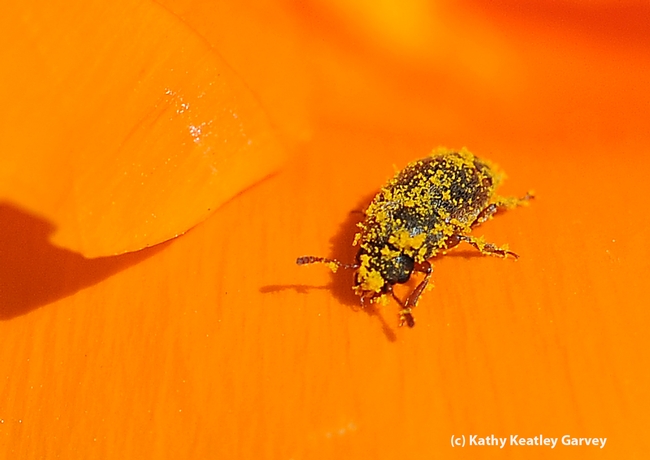- Author: Kathy Keatley Garvey
Look closely at a patch of California golden poppies and you may see a sweat bee (genus Halictus) collecting gold pollen. The pollen basket is on the hind legs but you'll see "gold" also dusting the head and abdomen.
Native bee, commonly known as "halictid bee." Native plant. In fact, the California golden poppy, Eschscholzia californica, is the state flower.
And the rumor that it's "protected" and you'll get arrested if you pick a poppy along a roadside is inaccurate.
The California Department of Fish and Wildlife sets the record straight on its website: "It is often believed that there are laws prohibiting the cutting or damaging of the California poppy because it is the state flower. While there is no law protecting the California poppy specifically, California Penal Code Section 384a(opens in new tab) requires written landowner permission to remove and sell plant material from land that a person does not own, and removing or damaging plants from property that a person does not own without permission may constitute trespass and/or petty theft. However, these laws do not prevent the collection of California poppies on private land by the landowner. California poppies are a beautiful and easy-to-grow addition to your garden, and although you may choose to pick them from your property, they last much longer in the ground!"
Want to learn more about native bees? California has some 1600 species of wild or non-managed bees. Be sure to read California Bees & Blooms: A Guide for Gardeners and Naturalists. It's the work of University of California authors, all with UC Berkeley connections: Gordon Frankie, now professor emeritus, UC Berkeley; Robbin Thorp (1933-2019), UC Davis distinguished emeritus professor who received his doctorate in entomology from UC Berkeley; photographer Rollin Coville, who holds a doctorate in entomology from UC Berkeley, and Barbara Ertter, curator at the UC Berkeley-based University Herbarium and Jepson Herbarium.
The Bohart Museum of Entomology is hosting an open house on bees, both wild and managed, from 1 to 4 p.m., Sunday, May 19 in Room 1124, Academic Surge Building, 455 Crocker Lane. It's free and family free.
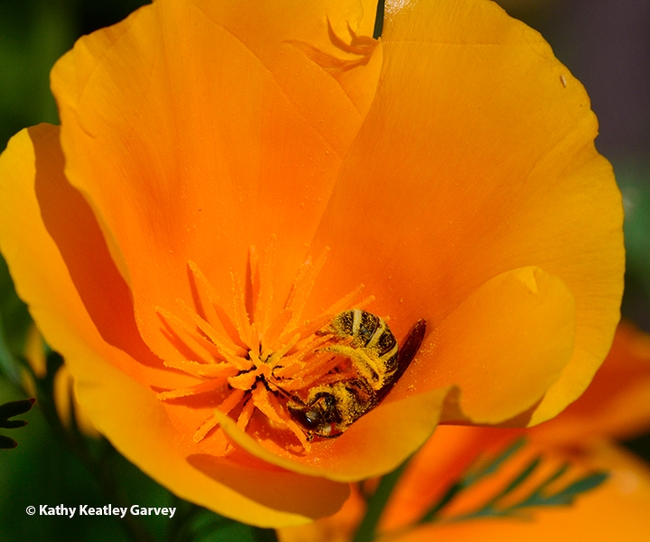
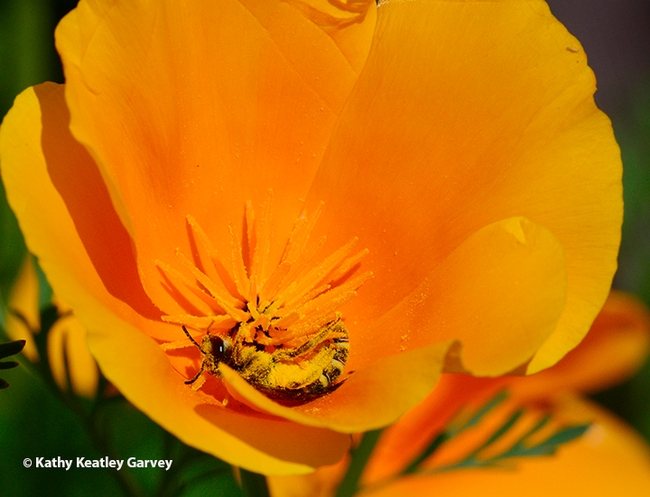
- Author: Kathy Keatley Garvey
There is no "Planet B."
The Earth is all we have.
Today, April 22, is Earth Day (an annual event launched April 22, 1970) and what a perfect occasion to celebrate a native bee and a native wildflower.
Bombus vosnesenskii,aka the yellow-faced bumble bee, meet the California golden poppy, Eschscholzia californica, the California state flower. (The California dogface butterfly, Zerene eurydice, is the state insect, but shouldn't B. vosnesenskii rank as a runner-up?)
Why do we celebrate Earth Day? "To demonstrate support for environmental protection," according to Wikipedia. "In 1969 at a UNESCO Conference in San Francisco, peace activist John McConnell proposed a day to honor the Earth and the concept of peace, to first be observed on March 21, 1970, the first day of spring in the northern hemisphere."
The late Robbin Thorp (1933-2019) distinguished emeritus professor, UC Davis Department of Entomology and Nematology, always encouraged us to look for, photograph and celebrate bumble bees. A tireless advocate of pollinator species protection and conservation, Thorp was known for his expertise, dedication and passion in protecting native pollinators, especially bumble bees, and for his teaching, research and public service. In his retirement, he co-authored two books Bumble Bees of North America: An Identification Guide (Princeton University, 2014) and California Bees and Blooms: A Guide for Gardeners and Naturalists (Heyday, 2014).
Seen any bumble bees lately? Connect with the California Bumble Bee Atlas. It's a project coordinated by the Xerces Society for Invertebrate Conservation. As its website says: It's a "collaborative community science effort to track and conserve the state's native bumble bee species.? ?This year's field work starts March 15, 2024!" Grants from the U.S. Fish and Wildlife Service's Wildlife and Sport Fish Restoration, the Bureau of Land Management, and other agencies support the project.
Happy E. Day...and Happy B. Day!
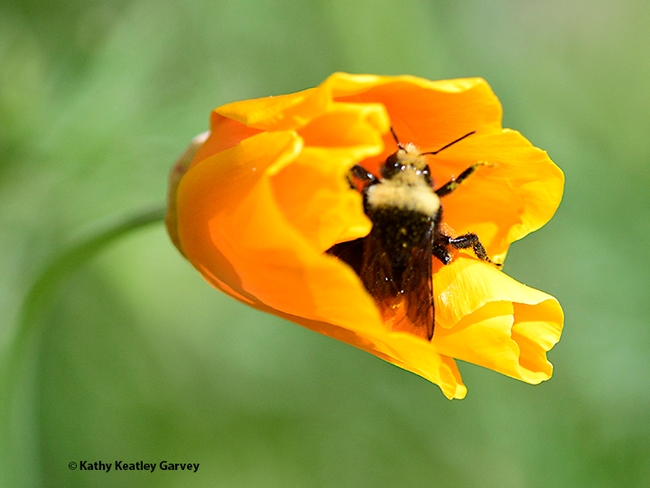
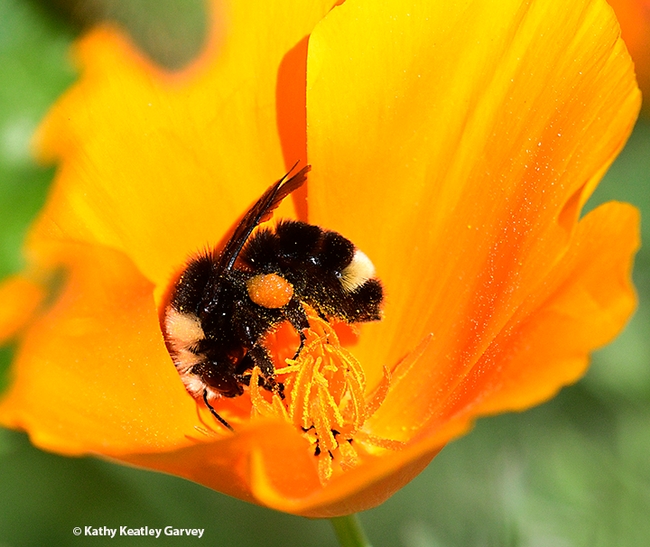
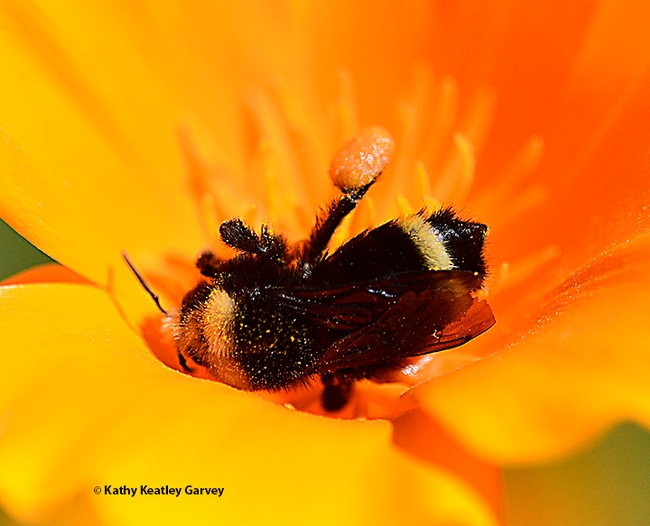
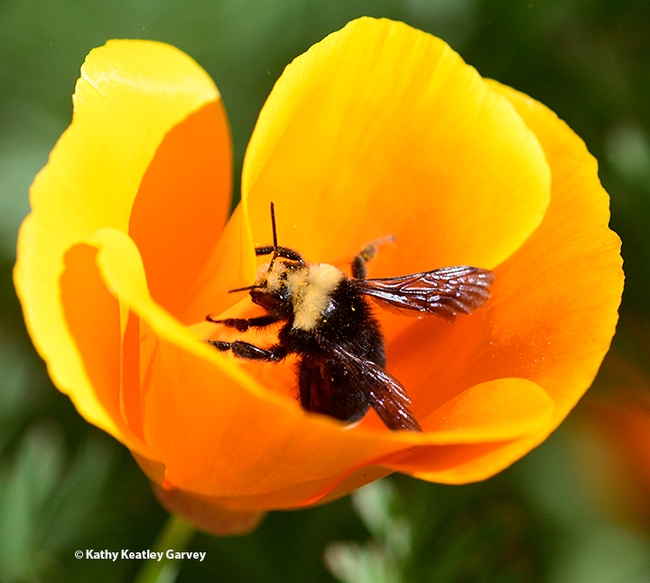
- Author: Kathy Keatley Garvey
Monarchs and California golden poppies...Color them orange...Color them bold...Color them beautiful...
And color them natives...
The California golden poppy, Eschscholzia californica, California's state flower, is popping up all over, while monarchs, Danaus plexippus, are winging their way inland from their overwintering sites along the California coast.
The overwintering population in California dropped this year by 30 percent as compared to last year, according to the Xerces Society for Invertebrate Conservation. The stormy weather didn't help.
"The 27th annual Thanksgiving count ran from November 11 through December 3, 2023, totaling 233,394 butterflies across 256 overwintering sites in the western United States," Xerces reports on its website. "This tally is slightly lower than last year's (330,000), yet similar to the 2021 count. The overwintering population of western monarchs remains at approximately 5% of its size in the 1980s."
Overall, habitat loss and increased use of pesticides and herbicides continue to be key factors in the decline of the monarch population.
Interestingly enough, both monarchs and California golden poppies are toxic. "All parts of the (California golden poppy) plant have toxic properties if ingested," according to the State of California Capitol Museum website. And, as we all know, monarchs are toxic. As caterpillars, monarchs sequester or store toxins from milkweed, and those toxins help protect them from predators. The coloring is also a deterrent.
Two natives, toxic, but beautiful...
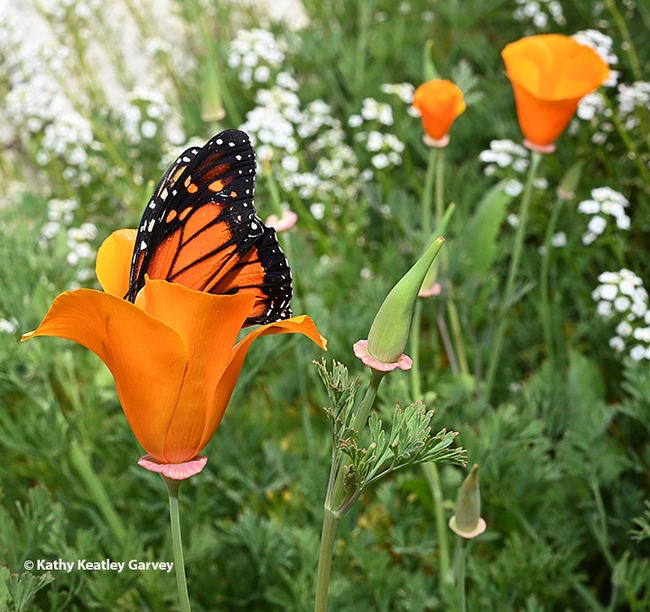
- Author: Kathy Keatley Garvey
A honey bee heads for a patch of California golden poppies. She finds a blossom she likes.
Bee: "Hey, Goldie Locks, I'm here to collect some nectar and pollen."
Goldie Locks: "You're what?"
Bee: "I want to collect some of your nectar and pollen."
Goldie Locks: "Don't you know that we California golden poppies don't have nectar--just pollen?"
Bee: "Oh? Really? I did not know that. Oh, well, pollen, then!"
Goldie Locks: "Sorry, bee. You're late. Don't you know that I close in the late afternoon?"
Bee: "Closed? What am I supposed to do?"
Goldie Locks: "Do? Come back tomorrow when I'm open for bees-ness."
Bee: Shakes her head, stomps her feet, and buzzes away.
Moral of the story: The early birds get the worm and the early bees get the pollen. And California golden poppies provide no nectar, just pollen.
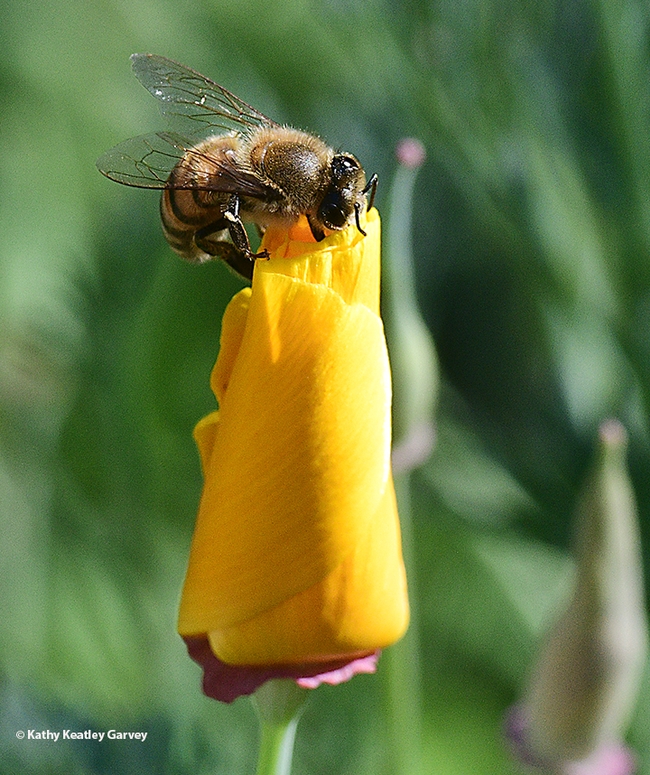
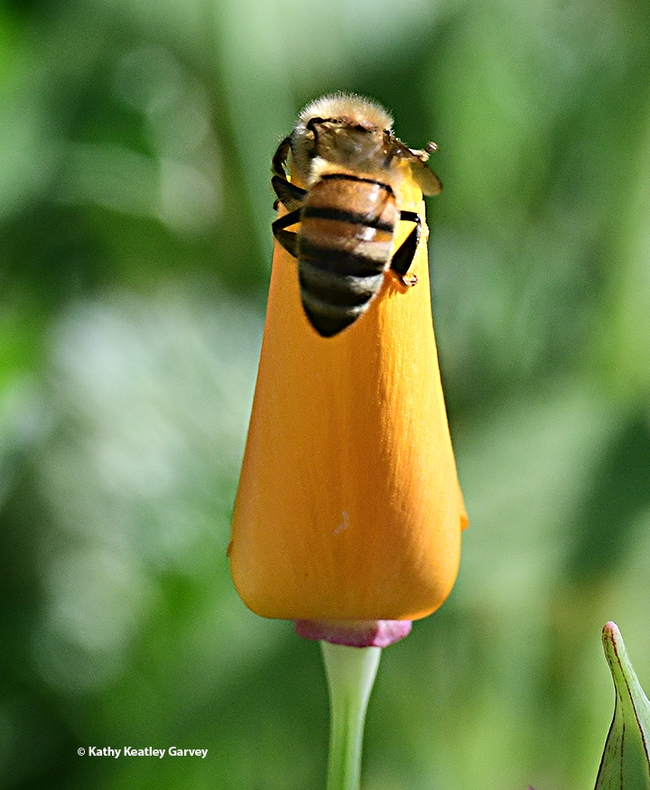
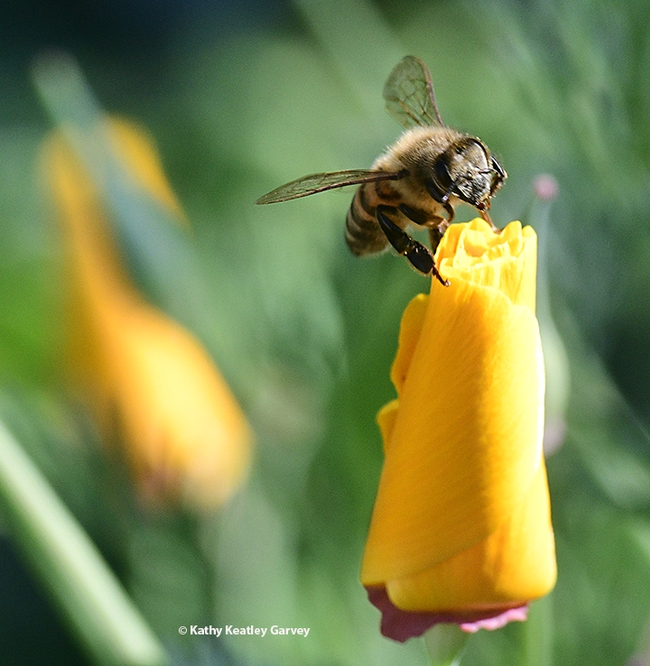
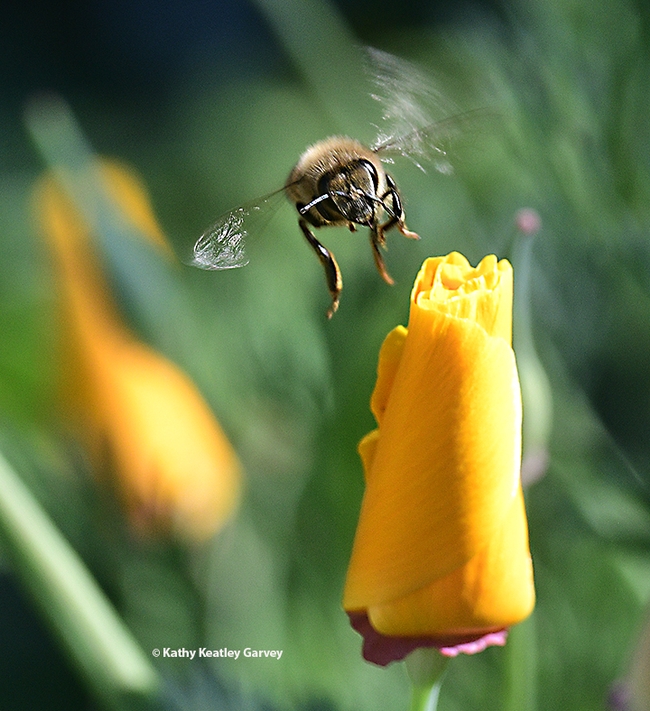
- Author: Kathy Keatley Garvey
Since this is National Pollinator Week, you're probably out celebrating the bees--maybe doing hand stands, cartwheels and pirouettes.
But have you ever thought about beetles as pollinators? They are.
We spotted this little critter on a California golden poppy at the Sonoma Mission in Sonoma, Calif. Native pollinator specialist Robbin Thorp, emeritus professor of entomology at UC Davis, knew what it was immediately, even though through all the pollen.
It's a melyrid beetle, a flightless beetle. Some species found elsewhere in the world are loaded with poison and are eaten by poison-dart frogs and passerine birds, including the pitohui. Scientists writing in the Proceedings of the National Academy of Sciences (PNAS) say these frogs and birds derive their poison from melyrid beetles and if they don't eat enough of them, they lose their toxicity. Indeed, there's a golden poison-dart frog that carries enough venom to kill 10 people, according to National Geographic.
If you want to know what this melyrid beetle looks like when it's not wearing its coat of many pollen grains, check out this photo by Peter Bryant of UC Irvine and another photo by Thomas Roach of Lincoln, Calif., an insect photographer and a frequent visitor to the Bohart Museum of Entomology on the UC Davis campus.

